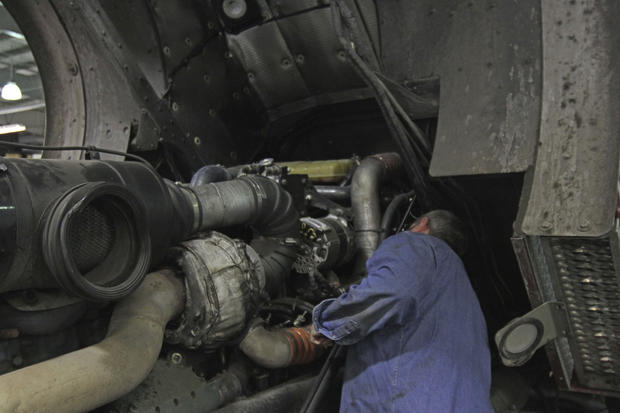9 industries with the biggest slumps in pay
The past 10 years represent a lost decade for many workers, thanks to stagnant and evening declining real wages.
Not all industries are hurting to the same degree, however. A majority of the 22 major occupation groups tracked by the Bureau of Labor Statistics witnessed declines in their annual average pay between 2004 through 2014, according to an analysis from the Federal Reserve Bank of Cleveland. Some of the declines were quite sharp, while other occupations saw just a moderate slip in annual income, which nevertheless can feel painful to workers given a rising cost of living. Only eight occupations benefited from wage increases during the past decade.
Stagnant and declining pay has been a hallmark of the post-recession years, leaving economists to puzzle over the causes. Higher-income workers have seen boosts to their paychecks, but the vast majority of Americans say their family's income is falling behind the cost of living, especially as the costs for services such as health care rise faster than inflation.
"Measuring from the end of the Great Recession, real wages have barely risen -- real compensation per hour has risen only by 0.5 percent, much less than at this point in past recoveries," wrote the bank's senior research economist Filippo Occhino and research analyst Timothy Stehulak in a recent publication.
One reason for the stagnant pay could be a shift in the composition of hours and jobs, with lower-paid work proliferating, lowering the country's average wage. But such a shift was small, the researchers point out.
Longer-term economic changes may be more to blame, such as a slowdown in labor productivity and the advancement of technology to produce goods and services, which has caused labor's share of income to decline at a faster rate since 2000, they added.
Regardless, American workers are feeling the pain when they sit down to pay their bills. For workers in the hardest-hit occupations, juggling their finances may be harder than ever.
On the other hand, some occupational groups have come out of the last decade with higher wages. The best performing field is health care practitioners and technical workers, who are making 5.8 percent more than in 2004, with average annual pay of $76,010 in 2014. Other groups that saw increases include architects and engineers, management, business and financial operations, and computer and mathematical professions.
Read on to find out the nine industries with the biggest declines in pay during the past decade.
9. Education/Training/Library: -1 percent
Workers in the education, training and library fields saw their real average annual wages decline by 1 percent during the past year. That means these employees were making an average of $52,741 in 2004 and only $52,210 in 2014.
Technology may be having an impact on these industries, with librarians facing job growth of 7 percent through 2022, lower than the 11 percent rate for all occupations, according to the BLS. The increased usage of electronic information and resources means fewer librarians will be needed, while budget cutbacks in local governments and educational services are taking a toll.
8. Farming/Fishing/Forestry: -1.2 percent
People working in the farming, fishing and forestry professions saw their real average annual wages decline 1.2 percent during the past decade. That means these workers were making $25,160 in 2014 compared to their average wages of $25,455 in 2004.
Agricultural workers, for one, are increasingly feeling technological changes as advancements in farm equipment lead to lower demand for workers. Those in the fishing industries have been hurt by catch limits, as well as competition from imports and farm-raised fish. Loggers are also facing foreign competition and limits on cultivation.
All farming, fishing and forestry occupations are projected to employ 3 percent fewer workers by 2022, compared with an 11 percent rise for all occupations, the BLS notes.
7. Transportation/Material moving: -1.4 percent
Workers in transportation and material moving have witnessed a 1.4 percent decline in real average annual wages. In 2004, these workers were making an average of $34,943 annually, which had declined to $34,460 by 2014.
These industries include truck drivers, taxi drivers, railroad workers, airline workers, bus drivers and more. Some segments within this industry are projected to have good growth opportunities, such as tractor-trailer drivers, but others, such as railroad operators, are facing some headwinds. In the rail industry, employment is expected to decline 3 percent by 2022 as freight companies find ways to increase capacity by running longer trains or double-stacking, according to the BLS.
6. Building/Grounds cleaning/Maintenance: -2.1 percent
Buildings, groundskeepers and maintenance workers are making 2.1 percent less than they did a decade ago. These workers made an average of $26,370 in 2014, compared with $26,934 in 2004, according to the study.
This group, which employs more than 4.3 million Americans, includes janitors, maids and housekeepers, pest control workers, and grounds maintenance workers. While all these jobs are expected to add workers at the same rate or even faster than average, low-wage professions in general haven't seen pay gains during the past decade.
5. Office/administrative support: -2.3 percent
Office and administrative workers are earning 2.3 percent less than they were in 2004. In dollar terms, that means the average salary last year was $35,530, compared with $36,372 a decade earlier.
This group includes office clerks, postal service workers, receptionists, administrative assistants and bank tellers, among other professions. Some of these jobs are at risk because new technologies are able to replace human workers, such as how ATMs and mobile banking can reduce the need for tellers.
4. Installation/maintenance/repair: -3.1 percent
This group, which employs 5.2 million Americans, has seen average annual wages slip 3.1 percent during the past decade. In 2004, these workers were making an average of $46,650, but that had declined to $45,220 by last year.
Workers in this group include a wide range of occupations, from watch repairers to truck mechanics. While each profession has its own outlook, some workers may face continued speed bumps, such as office equipment repairers, given that the lower cost of equipment means it may be cheaper for companies to replace computers than getting them repaired, the BLS notes.
In other fields, equipment is becoming more reliable, which is lowering demand for repair people.
3. Production: -3.3 percent
Production workers are earning 3.3 percent less than they were in 2004. That translates to an average annual wage of $35,490 last year, compared with $36,698 a decade ago.
Production occupations include everything from bakers to welders, according to the BLS. Many of these jobs are facing slower-than-average growth, while metal and plastic machine workers will see employment decline by 6 percent through 2022 because of a technological shift in factories that requires fewer low-skilled workers, the BLS says.
2. Sales and related fields: -4.2 percent
Salespeople haven't necessarily sold their employers on higher salaries. The average worker in this occupational group earned $38,660 last year, down from $40,370 in 2004.
Retail companies have been adding low-wage jobs, including salespeople, but workers may be suffering from stagnant wages given a federal minimum wage that hasn't changed for six years. At the same time, the cost of living has continued to rise, putting a damper on household finances for this group.
1. Personal care/service: -8.6 percent
The worst-performing industry over the past decade is personal care and service. Workers in this group earned $24,980 on average last year. That's down 8.6 percent from $27,323 in 2004.
These workers include child care workers, personal care aides and hairdressers, among other occupations. Many of these groups offer low-pay or even the tipped minimum wage (in the case of hairdressers), which has been stuck at $2.13 an hour since 1991. Tipped workers are more likely to live in poverty and rely on government aid.
Other groups, such as home health aides, have seen their hourly wages decline during the past decade, despite higher demand for their services. Wages have suffered because, in the case of home health aides, workers are excluded from wage protections and lack union representation. A number of low-skilled workers are also are employed in a number of these fields.









